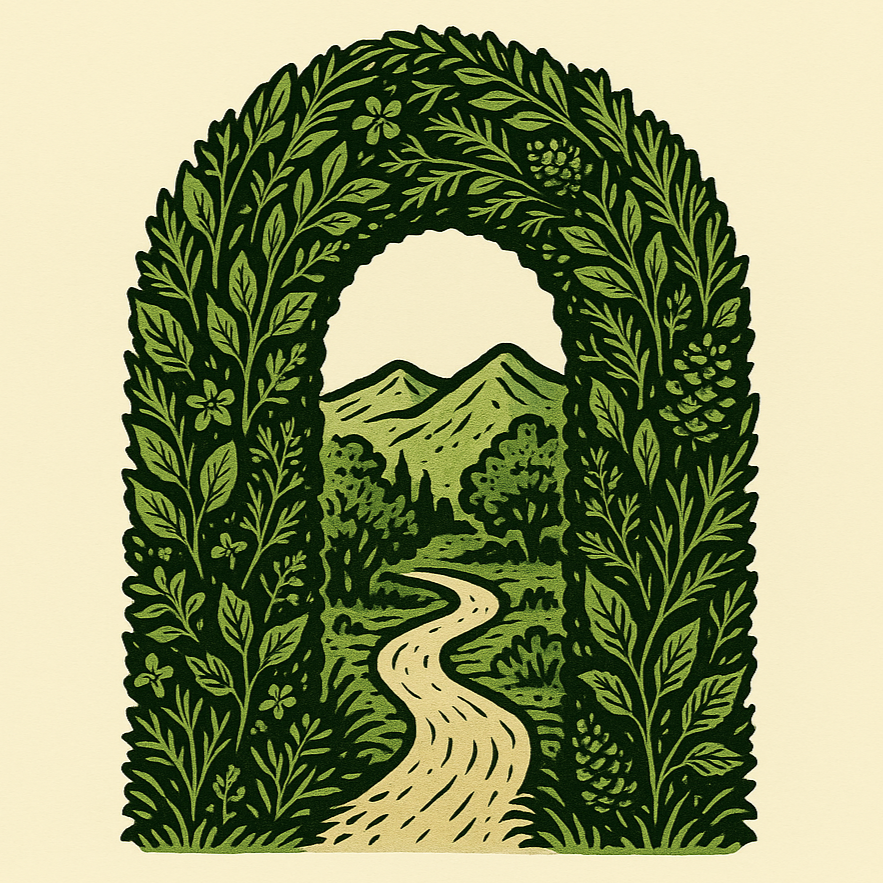A Field Guide to Verdant Way
Five steps to bridge botanical knowledge with herbal practice
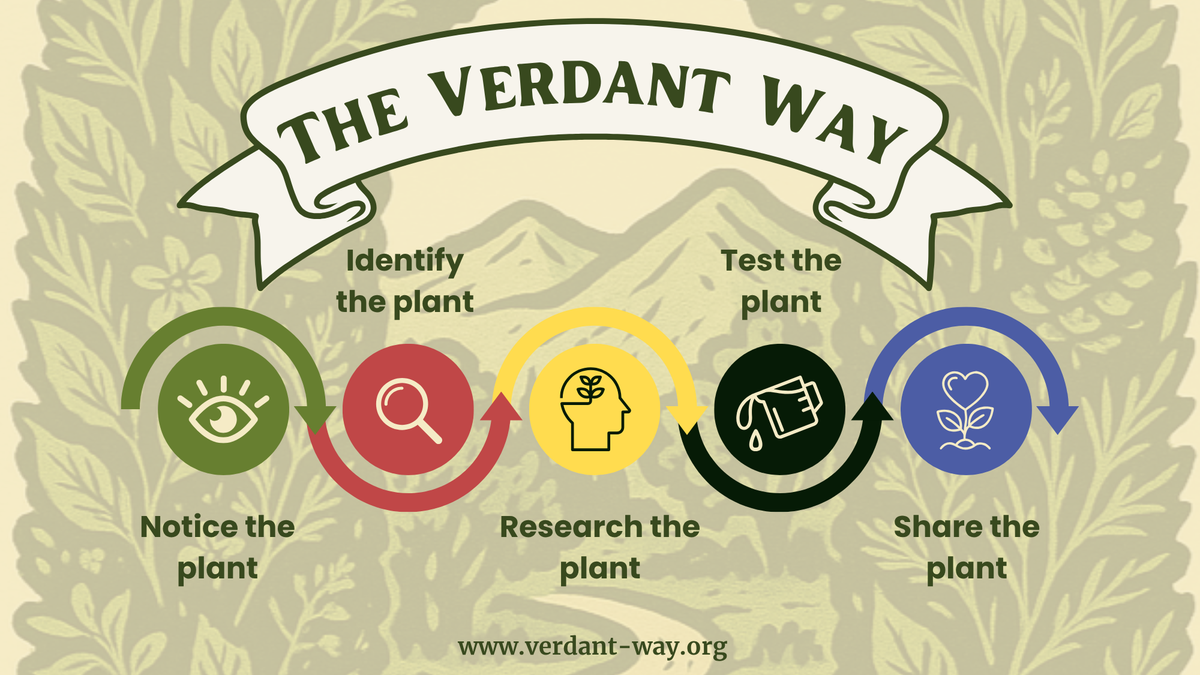
At its core, Verdant Way is a process that bridges plants and people. Anything you see on Verdant Way is part of this process in some way. To demonstrate, we'll take a common medicinal herb - Mullein (Verbascum thapsus) through the process, step by step.
Process Overview
The Verdant Way is comprised of five phases or steps that take us from botanical obscurity to field herbalism. As you'll see, each part of the process holds a piece of the puzzle that makes the plant come alive as a field herb, rather than remaining an unknown weed or an obscure piece of traditional lore.
"Field herbalism" is the herbalism of Verdant Way; a combination of botanical, scientific, and traditional knowledge that encompasses the whole plant.
By following this path, using mullein as our example, we unlock both sides of the bridge - all of the plant's essential history and properties, plus the ways that humans have processed and used these herbs, often over millennia.
Step 1: Notice a plant.
It doesn't matter why you notice a plant. Some people say plants call to them, while others follow their own curiosity. When you ask yourself something like, "What is growing there?" – chances are, you noticed a plant.
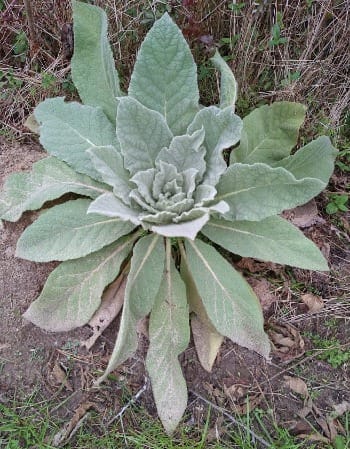
I first noticed the mullein plant pictured above because of its size, and also because it's lighter than the foliage around it.
Step 2: Identify the plant.
Identification is essential when working with plants as herbal medicines. In fact, field herbalists should not begin testing and working with herbs until their identification skills are on point.
Identification aids like iNaturalist bring important awareness of similar species and commonly confused plants in the area. It's an excellent tool for narrowing botanical research and helping to identify plants quickly.

While nothing quite compares to seeing and experiencing a plant in real life, iNaturalist is an invaluable resource to learn, track, and communicate with other herbalists. While Verdant Way is primarily a botanical resource, iNaturalist spans many other areas of scientific observation, such as animals and insects. The project is of ever-growing importance as we continue to restore beneficial stewardship of our forests and resources.
This is the observation record for the mullein plant I saw earlier: 🌱 Verbascum thapsus on iNaturalist.org
Step 3: Research the plant.
It often starts with iNaturalist, but there are more areas of research that involve the historical and medicinal components of our task. In order to practice field herbalism effectively, we need to understand how herbs have been used in the past.
From modern resources on herbalism to older texts, classical practices and even folklore, the research serves as compost for the growth of our understanding. Every herb has a lesson to teach, sometimes an invitation, other times a warning. Research is an opportunity to use plants as companions for reflection rather than specimens for study or tools for use.
Reflections include curiosities and questions such as, "Why this part of the plant?" and "How was this made?" as well as, "What did that taste like?" and "Is it safe to prepare that way?" These questions invite further research and a plant profile is assembled.

In the case of Verbascum thapsus, I reviewed herbal texts from Chinese medicine and examined scientific research studies done in Europe and the United States. I explored the historical uses of mullein - one of a few herbs that were therapeutically smoked - and contemplated the symbolic meanings that have been assigned to the soft, fuzzy bright bloomer.
Read my research reflection here.
Step 4: Test the plant.
Once the research is finished, I plan a presentation of the herb that showcases its best properties. Dried herbs and extracts tend to preserve the active or medicinal components, depending on the plant parts used.
Barks, twigs and roots lend better to alcohol tinctures than other methods of extraction, while leaves and flowers extract very well in glycerin. Keeping dried excess is a handy way to stock up when fresh isn't readily available. A fresh extract has all the volatile compounds that make some leaves and flowers effective, while drying is not only preservation, but also concentration.
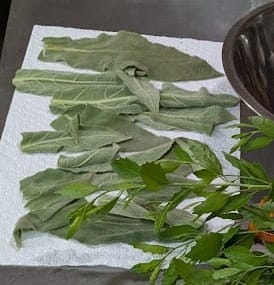
Mullein leaves and stalks can be dried - it's just important to know that the leaf hairs can be irritating and must be filtered out of any consumables.
Verdant Way celebrates mullein with:
- A mullein extract made with macerated fresh leaves
- Dried leaves for tea (and smoking/burning, if desired)
- Mullein torches dipped in fragrant wax rendered from local plants - coming this fall!
Step 5: Share the plant
Once we have developed a relationship with a medicinal herb and tested it, it's time to share our findings with the world! Here are some breadcrumbs that will lead you back to the House of Mullein:
- Field Observations on iNaturalist and Instagram
- Mullein on Verdant Way
- Mullein in our Shop
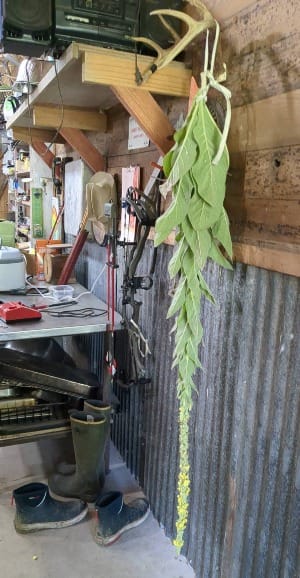
As you can see, the process of Verdant Way creates an herbal narrative, showing our work with nature and contributing to biodiversity and scientific observation. We're also giving other people tools to take charge of their own wellness. This approach bridges people and plants in the fullest way possible, with the tools that we have, right now. The message of modern field herbalism is to bring the pharmacy into nature rather than attempt to squeeze nature into the pharmacy.
If you are curious about these plants, you're in the right place. If you're interested in harnessing the medicinal nature of the plants around us, you belong here.
Walk the Way
- Sign up for seasonal emails and new discoveries
- Visit the apothecary
- Keep reading about Mullein
Our study of medicinal herbs is fueled by curiosity and resonance. If this process feels like your way, then you’re already on the path.
